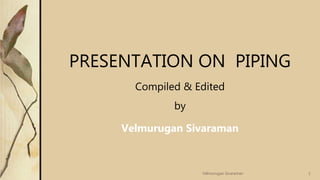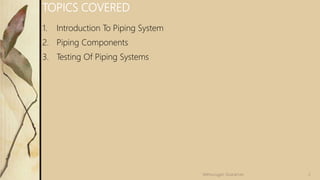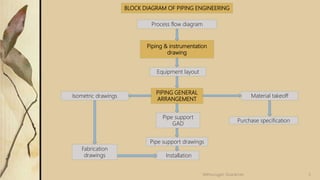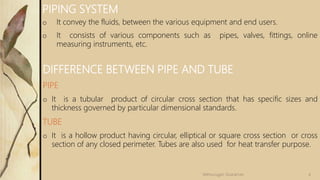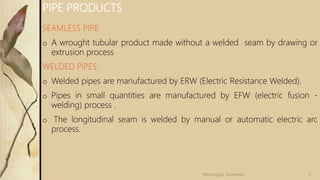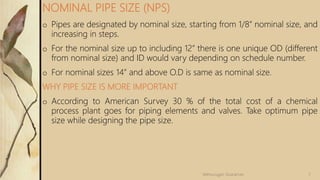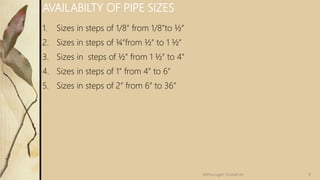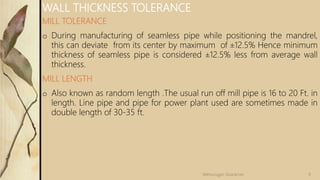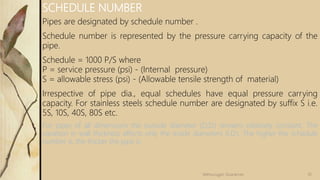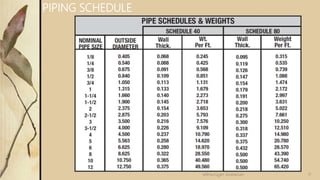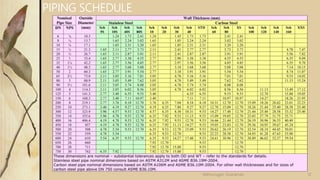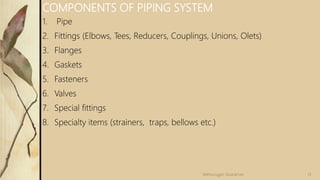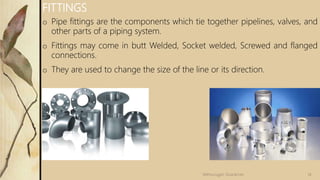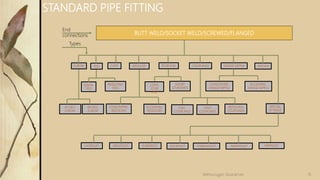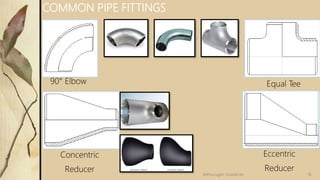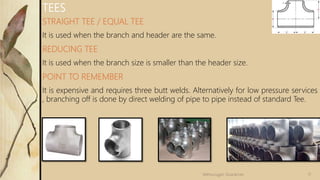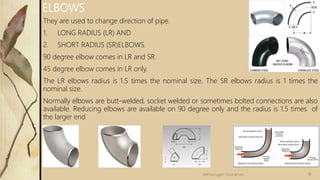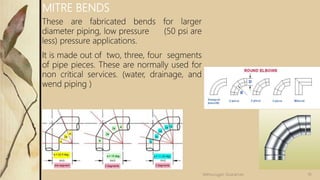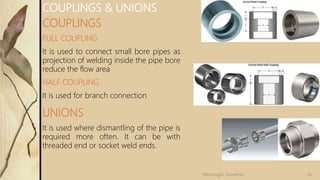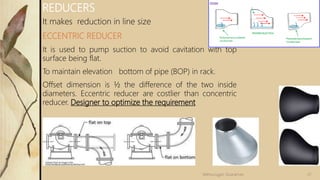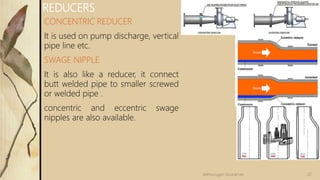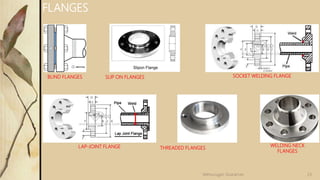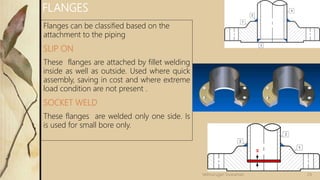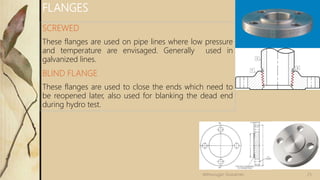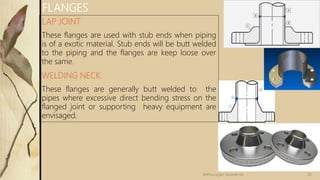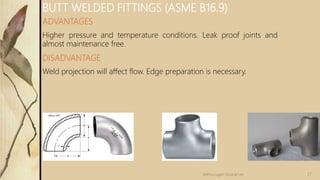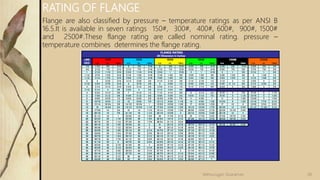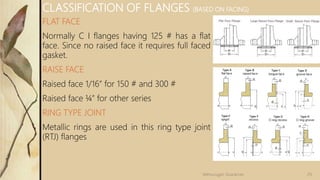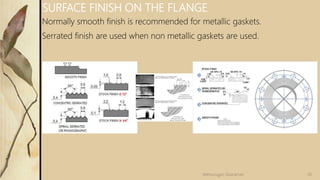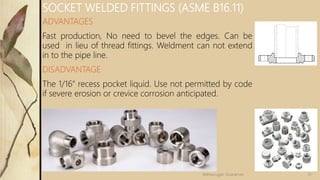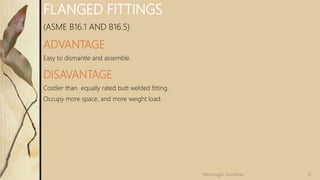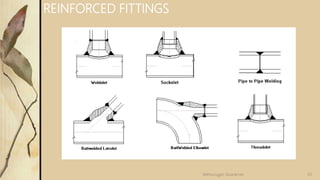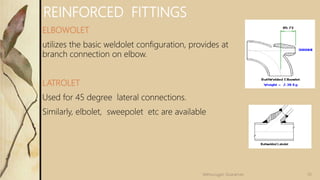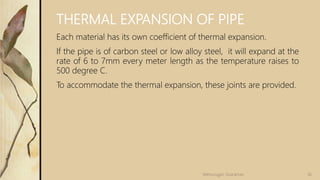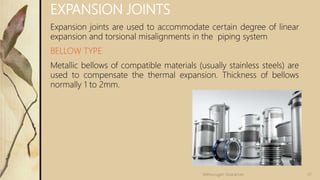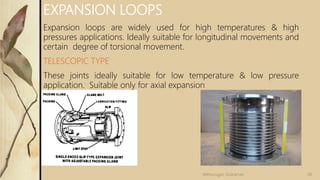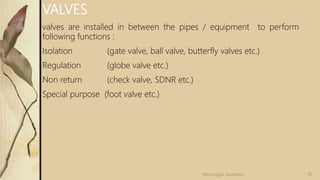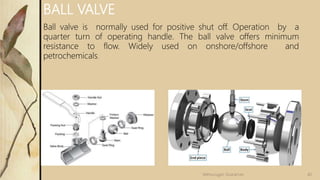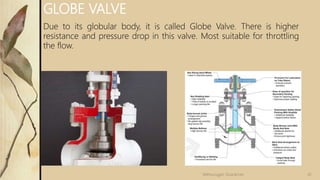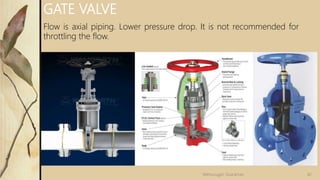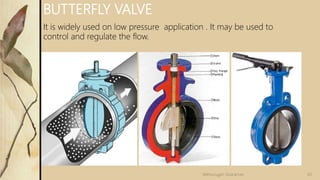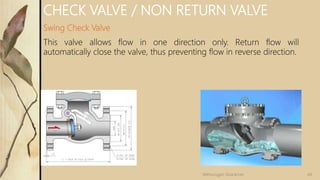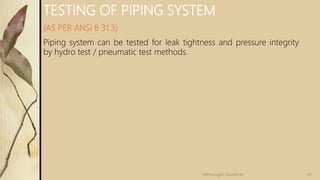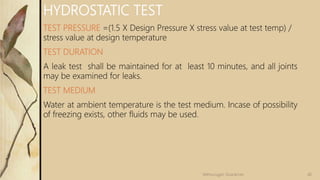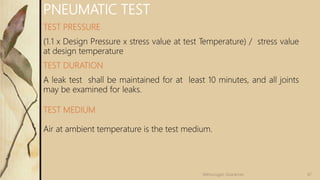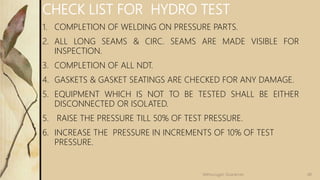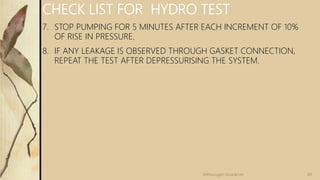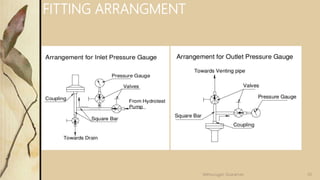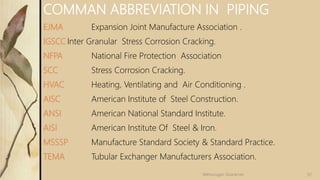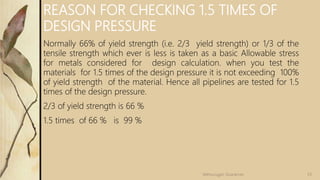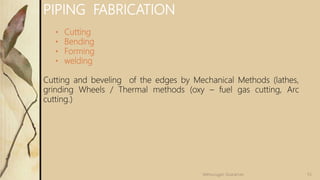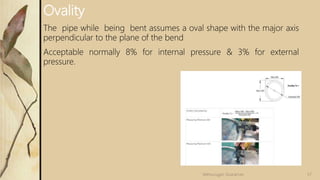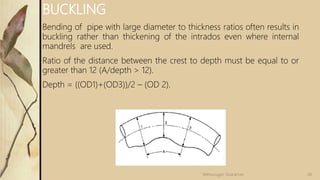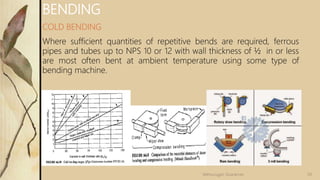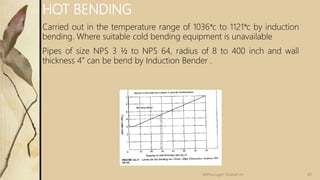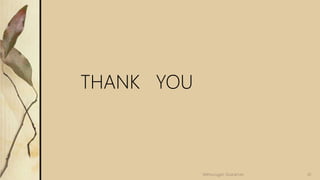Piping presentation (master)
- 1. PRESENTATION ON PIPING Compiled & Edited by Velmurugan Sivaraman 1Velmurugan Sivaraman
- 2. TOPICS COVERED 1. Introduction To Piping System 2. Piping Components 3. Testing Of Piping Systems 2Velmurugan Sivaraman
- 3. BLOCK DIAGRAM OF PIPING ENGINEERING Process flow diagram Equipment layout PIPING GENERAL ARRANGEMENT Material takeoff Purchase specification Pipe support GAD Pipe support drawings Installation Isometric drawings Fabrication drawings Piping & instrumentation drawing 3Velmurugan Sivaraman
- 4. o It convey the fluids, between the various equipment and end users. o It consists of various components such as pipes, valves, fittings, online measuring instruments, etc. PIPING SYSTEM DIFFERENCE BETWEEN PIPE AND TUBE PIPE o It is a tubular product of circular cross section that has specific sizes and thickness governed by particular dimensional standards. TUBE o It is a hollow product having circular, elliptical or square cross section or cross section of any closed perimeter. Tubes are also used for heat transfer purpose. 4Velmurugan Sivaraman
- 5. SEAMLESS PIPE o A wrought tubular product made without a welded seam by drawing or extrusion process WELDED PIPES o Welded pipes are manufactured by ERW (Electric Resistance Welded). o Pipes in small quantities are manufactured by EFW (electric fusion - welding) process . o The longitudinal seam is welded by manual or automatic electric arc process. PIPE PRODUCTS 5Velmurugan Sivaraman
- 6. LINE PIPE o It is mainly used for conveying fluids over long distances and are subjected to fluid pressure. It is usually not subjected to high temperature. PRESSURE PIPE o These are subjected to fluid pressure and /or temperature. Fluid pressure in generally internal pressure or may be external pressure (e.g. Jacketed piping )and are mainly used as plant piping. STRUCTURAL PIPE o These are not used for conveying fluids and not subjected to fluid pressures or temperature. They are used as structural components (e.g. handrails, columns, sleeves etc.) and are subjected to static loads only. CLASSIFICATION BASED ON END USE 6Velmurugan Sivaraman
- 7. o Pipes are designated by nominal size, starting from 1/8” nominal size, and increasing in steps. o For the nominal size up to including 12” there is one unique OD (different from nominal size) and ID would vary depending on schedule number. o For nominal sizes 14” and above O.D is same as nominal size. WHY PIPE SIZE IS MORE IMPORTANT o According to American Survey 30 % of the total cost of a chemical process plant goes for piping elements and valves. Take optimum pipe size while designing the pipe size. NOMINAL PIPE SIZE (NPS) 7Velmurugan Sivaraman
- 8. 1. Sizes in steps of 1/8” from 1/8”to ½” 2. Sizes in steps of ¼”from ½” to 1 ½” 3. Sizes in steps of ½” from 1 ½” to 4” 4. Sizes in steps of 1” from 4” to 6” 5. Sizes in steps of 2” from 6” to 36” AVAILABILTY OF PIPE SIZES 8Velmurugan Sivaraman
- 9. MILL TOLERANCE o During manufacturing of seamless pipe while positioning the mandrel, this can deviate from its center by maximum of ±12.5% Hence minimum thickness of seamless pipe is considered ±12.5% less from average wall thickness. MILL LENGTH o Also known as random length .The usual run off mill pipe is 16 to 20 Ft. in length. Line pipe and pipe for power plant used are sometimes made in double length of 30-35 ft. WALL THICKNESS TOLERANCE 9Velmurugan Sivaraman
- 10. Pipes are designated by schedule number . Schedule number is represented by the pressure carrying capacity of the pipe. Schedule = 1000 P/S where P = service pressure (psi) - (Internal pressure) S = allowable stress (psi) - (Allowable tensile strength of material) Irrespective of pipe dia., equal schedules have equal pressure carrying capacity. For stainless steels schedule number are designated by suffix S i.e. 5S, 10S, 40S, 80S etc. For pipes of all dimensions the outside diameter (O.D.) remains relatively constant. The variation in wall thickness affects only the inside diameters (I.D.). The higher the schedule number is, the thicker the pipe is. SCHEDULE NUMBER 10Velmurugan Sivaraman
- 13. 1. Pipe 2. Fittings (Elbows, Tees, Reducers, Couplings, Unions, Olets) 3. Flanges 4. Gaskets 5. Fasteners 6. Valves 7. Special fittings 8. Specialty items (strainers, traps, bellows etc.) COMPONENTS OF PIPING SYSTEM 13Velmurugan Sivaraman
- 14. o Pipe fittings are the components which tie together pipelines, valves, and other parts of a piping system. o Fittings may come in butt Welded, Socket welded, Screwed and flanged connections. o They are used to change the size of the line or its direction. FITTINGS 14Velmurugan Sivaraman
- 15. BUTT WELD/SOCKET WELD/SCREWED/FLANGED ELBOW TEES CAPS REDUCER STUB END COUPLINGS SWAGE NIPPLE UNIONS SPECIAL FITTINGS 45 DEG. ELBOW 90 DEG. ELBOW EQUAL TEES REDUCING TEES CONCENTRIC REDUCERS ECCENTRIC REDUCERS LONG STUB END SHORT STUB ENDS FULL COUPLINGS REDUCING COUPLINGS CONCENTRIC SWAGE NIPPLE ECCENTRIC SWAGE NIPPLE HALF COUPLINGS LATROLET WELDOLET ELBOWLET SOCKOLET THREADOLET SWEEPOLET NIPPOLET End connections Types STANDARD PIPE FITTING 15Velmurugan Sivaraman
- 16. 90° Elbow Concentric Reducer Eccentric Reducer COMMON PIPE FITTINGS Equal Tee 16Velmurugan Sivaraman
- 17. STRAIGHT TEE / EQUAL TEE It is used when the branch and header are the same. REDUCING TEE It is used when the branch size is smaller than the header size. POINT TO REMEMBER It is expensive and requires three butt welds. Alternatively for low pressure services , branching off is done by direct welding of pipe to pipe instead of standard Tee. TEES 17Velmurugan Sivaraman
- 18. They are used to change direction of pipe. 1. LONG RADIUS (LR) AND 2. SHORT RADIUS (SR)ELBOWS. 90 degree elbow comes in LR and SR. 45 degree elbow comes in LR only. The LR elbows radius is 1.5 times the nominal size. The SR elbows radius is 1 times the nominal size. Normally elbows are butt-welded, socket welded or sometimes bolted connections are also available. Reducing elbows are available on 90 degree only and the radius is 1.5 times of the larger end ELBOWS 18Velmurugan Sivaraman
- 19. These are fabricated bends for larger diameter piping, low pressure (50 psi are less) pressure applications. It is made out of two, three, four segments of pipe pieces. These are normally used for non critical services. (water, drainage, and wend piping ) MITRE BENDS 19Velmurugan Sivaraman
- 20. COUPLINGS FULL COUPLING It is used to connect small bore pipes as projection of welding inside the pipe bore reduce the flow area HALF COUPLING It is used for branch connection UNIONS It is used where dismantling of the pipe is required more often. It can be with threaded end or socket weld ends. COUPLINGS & UNIONS 20Velmurugan Sivaraman
- 21. It makes reduction in line size ECCENTRIC REDUCER It is used to pump suction to avoid cavitation with top surface being flat. To maintain elevation bottom of pipe (BOP) in rack. Offset dimension is ½ the difference of the two inside diameters. Eccentric reducer are costlier than concentric reducer. Designer to optimize the requirement REDUCERS 21Velmurugan Sivaraman
- 22. CONCENTRIC REDUCER It is used on pump discharge, vertical pipe line etc. SWAGE NIPPLE It is also like a reducer, it connect butt welded pipe to smaller screwed or welded pipe . concentric and eccentric swage nipples are also available. REDUCERS 22Velmurugan Sivaraman
- 23. SOCKET WELDING FLANGESLIP ON FLANGESBLIND FLANGES LAP-JOINT FLANGE THREADED FLANGES WELDING NECK FLANGES FLANGES 23Velmurugan Sivaraman
- 24. FLANGES Flanges can be classified based on the attachment to the piping SLIP ON These flanges are attached by fillet welding inside as well as outside. Used where quick assembly, saving in cost and where extreme load condition are not present . SOCKET WELD These flanges are welded only one side. Is is used for small bore only. 24Velmurugan Sivaraman
- 25. SCREWED These flanges are used on pipe lines where low pressure and temperature are envisaged. Generally used in galvanized lines. BLIND FLANGE These flanges are used to close the ends which need to be reopened later, also used for blanking the dead end during hydro test. FLANGES 25Velmurugan Sivaraman
- 26. LAP JOINT These flanges are used with stub ends when piping is of a exotic material. Stub ends will be butt welded to the piping and the flanges are keep loose over the same. WELDING NECK These flanges are generally butt welded to the pipes where excessive direct bending stress on the flanged joint or supporting heavy equipment are envisaged. FLANGES 26Velmurugan Sivaraman
- 27. ADVANTAGES Higher pressure and temperature conditions. Leak proof joints and almost maintenance free. DISADVANTAGE Weld projection will affect flow. Edge preparation is necessary. BUTT WELDED FITTINGS (ASME B16.9) 27Velmurugan Sivaraman
- 28. Flange are also classified by pressure – temperature ratings as per ANSI B 16.5.It is available in seven ratings 150#, 300#, 400#, 600#, 900#, 1500# and 2500#.These flange rating are called nominal rating. pressure – temperature combines determines the flange rating. RATING OF FLANGE 28Velmurugan Sivaraman
- 29. FLAT FACE Normally C I flanges having 125 # has a flat face. Since no raised face it requires full faced gasket. RAISE FACE Raised face 1/16” for 150 # and 300 # Raised face ¼” for other series RING TYPE JOINT Metallic rings are used in this ring type joint (RTJ) flanges CLASSIFICATION OF FLANGES (BASED ON FACING) 29Velmurugan Sivaraman
- 30. Normally smooth finish is recommended for metallic gaskets. Serrated finish are used when non metallic gaskets are used. SURFACE FINISH ON THE FLANGE 30Velmurugan Sivaraman
- 31. ADVANTAGES Fast production, No need to bevel the edges. Can be used in lieu of thread fittings. Weldment can not extend in to the pipe line. DISADVANTAGE The 1/16” recess pocket liquid. Use not permitted by code if severe erosion or crevice corrosion anticipated. SOCKET WELDED FITTINGS (ASME B16.11) 31Velmurugan Sivaraman
- 32. FLANGED FITTINGS (ASME B16.1 AND B16.5) ADVANTAGE Easy to dismantle and assemble. DISAVANTAGE Costlier than equally rated butt welded fitting. Occupy more space, and more weight load. 32Velmurugan Sivaraman
- 34. REINFORCED FITTINGS WELDOLET An economical butt -weld branch connection, is designed to minimize stress concentration and provide integral reinforcement. SOCKOLET Utilizes the basic weldolet design configuration and incorporates a sockolet -weld outlet. 34Velmurugan Sivaraman
- 35. REINFORCED FITTINGS ELBOWOLET utilizes the basic weldolet configuration, provides at branch connection on elbow. LATROLET Used for 45 degree lateral connections. Similarly, elbolet, sweepolet etc are available 35Velmurugan Sivaraman
- 36. THERMAL EXPANSION OF PIPE Each material has its own coefficient of thermal expansion. If the pipe is of carbon steel or low alloy steel, it will expand at the rate of 6 to 7mm every meter length as the temperature raises to 500 degree C. To accommodate the thermal expansion, these joints are provided. 36Velmurugan Sivaraman
- 37. EXPANSION JOINTS Expansion joints are used to accommodate certain degree of linear expansion and torsional misalignments in the piping system BELLOW TYPE Metallic bellows of compatible materials (usually stainless steels) are used to compensate the thermal expansion. Thickness of bellows normally 1 to 2mm. 37Velmurugan Sivaraman
- 38. EXPANSION LOOPS Expansion loops are widely used for high temperatures & high pressures applications. Ideally suitable for longitudinal movements and certain degree of torsional movement. TELESCOPIC TYPE These joints ideally suitable for low temperature & low pressure application. Suitable only for axial expansion 38Velmurugan Sivaraman
- 39. VALVES valves are installed in between the pipes / equipment to perform following functions : Isolation (gate valve, ball valve, butterfly valves etc.) Regulation (globe valve etc.) Non return (check valve, SDNR etc.) Special purpose (foot valve etc.) 39Velmurugan Sivaraman
- 40. BALL VALVE Ball valve is normally used for positive shut off. Operation by a quarter turn of operating handle. The ball valve offers minimum resistance to flow. Widely used on onshore/offshore and petrochemicals. 40Velmurugan Sivaraman
- 41. GLOBE VALVE Due to its globular body, it is called Globe Valve. There is higher resistance and pressure drop in this valve. Most suitable for throttling the flow. 41Velmurugan Sivaraman
- 42. GATE VALVE Flow is axial piping. Lower pressure drop. It is not recommended for throttling the flow. 42Velmurugan Sivaraman
- 43. BUTTERFLY VALVE It is widely used on low pressure application . It may be used to control and regulate the flow. 43Velmurugan Sivaraman
- 44. CHECK VALVE / NON RETURN VALVE Swing Check Valve This valve allows flow in one direction only. Return flow will automatically close the valve, thus preventing flow in reverse direction. 44Velmurugan Sivaraman
- 45. TESTING OF PIPING SYSTEM (AS PER ANSI B 31.3) Piping system can be tested for leak tightness and pressure integrity by hydro test / pneumatic test methods. 45Velmurugan Sivaraman
- 46. HYDROSTATIC TEST TEST PRESSURE =(1.5 X Design Pressure X stress value at test temp) / stress value at design temperature TEST DURATION A leak test shall be maintained for at least 10 minutes, and all joints may be examined for leaks. TEST MEDIUM Water at ambient temperature is the test medium. Incase of possibility of freezing exists, other fluids may be used. 46Velmurugan Sivaraman
- 47. PNEUMATIC TEST TEST PRESSURE (1.1 x Design Pressure x stress value at test Temperature) / stress value at design temperature TEST DURATION A leak test shall be maintained for at least 10 minutes, and all joints may be examined for leaks. TEST MEDIUM Air at ambient temperature is the test medium. 47Velmurugan Sivaraman
- 48. CHECK LIST FOR HYDRO TEST 1. COMPLETION OF WELDING ON PRESSURE PARTS. 2. ALL LONG SEAMS & CIRC. SEAMS ARE MADE VISIBLE FOR INSPECTION. 3. COMPLETION OF ALL NDT. 4. GASKETS & GASKET SEATINGS ARE CHECKED FOR ANY DAMAGE. 5. EQUIPMENT WHICH IS NOT TO BE TESTED SHALL BE EITHER DISCONNECTED OR ISOLATED. 5. RAISE THE PRESSURE TILL 50% OF TEST PRESSURE. 6. INCREASE THE PRESSURE IN INCREMENTS OF 10% OF TEST PRESSURE. 48Velmurugan Sivaraman
- 49. CHECK LIST FOR HYDRO TEST 7. STOP PUMPING FOR 5 MINUTES AFTER EACH INCREMENT OF 10% OF RISE IN PRESSURE. 8. IF ANY LEAKAGE IS OBSERVED THROUGH GASKET CONNECTION, REPEAT THE TEST AFTER DEPRESSURISING THE SYSTEM. 49Velmurugan Sivaraman
- 51. IMPORTANT SAFETY POINTS • DRAIN THE PIPE ONLY WHEN TOP OUT LET IS KEPT OPEN. • USE MINIMUM 2 GAUGES FOR ANY HYDROTEST. • NEVER USE HIGH DISCHARGE PUMPS FOR TESTING LOW VOLUME PIPE. ( VOLUM LESS THAN 10 M3). • NEVER PRESSURISE ANY VESSEL ABOVE TEST PRESSURE. 51Velmurugan Sivaraman
- 52. COMMAN ABBREVIATION IN PIPING EJMA Expansion Joint Manufacture Association . IGSCC Inter Granular Stress Corrosion Cracking. NFPA National Fire Protection Association SCC Stress Corrosion Cracking. HVAC Heating, Ventilating and Air Conditioning . AISC American Institute of Steel Construction. ANSI American National Standard Institute. AISI American Institute Of Steel & Iron. MSSSP Manufacture Standard Society & Standard Practice. TEMA Tubular Exchanger Manufacturers Association. 52Velmurugan Sivaraman
- 53. REASON FOR CHECKING 1.5 TIMES OF DESIGN PRESSURE Normally 66% of yield strength (i.e. 2/3 yield strength) or 1/3 of the tensile strength which ever is less is taken as a basic Allowable stress for metals considered for design calculation. when you test the materials for 1.5 times of the design pressure it is not exceeding 100% of yield strength of the material. Hence all pipelines are tested for 1.5 times of the design pressure. 2/3 of yield strength is 66 % 1.5 times of 66 % is 99 % 53Velmurugan Sivaraman
- 54. REASON FOR 22% ELONGATION ON STEEL. Normally 12 % of the ductility required in final product during manufacturing. 6 to 8 % ductility lost in manufacturing and 2 % is considered for non - homogenous material. Hence material selected should have minimum 22% elongation. 54Velmurugan Sivaraman
- 55. 55Velmurugan Sivaraman PIPING FABRICATION • Cutting • Bending • Forming • welding Cutting and beveling of the edges by Mechanical Methods (lathes, grinding Wheels / Thermal methods (oxy – fuel gas cutting, Arc cutting.)
- 56. 56Velmurugan Sivaraman PIPING THINNING Bending results in the thinning of the outer surface (extrados ) and thickening of the inner surface (intrados ) of the pipe. It can be approximated by multiplying the thickness of the pipe before bending by R/(R+ r) Where R - Radius of Bend & r - Pipe radius. ( Half of the O.D )
- 57. Ovality The pipe while being bent assumes a oval shape with the major axis perpendicular to the plane of the bend Acceptable normally 8% for internal pressure & 3% for external pressure. 57Velmurugan Sivaraman
- 58. BUCKLING Bending of pipe with large diameter to thickness ratios often results in buckling rather than thickening of the intrados even where internal mandrels are used. Ratio of the distance between the crest to depth must be equal to or greater than 12 (A/depth > 12). Depth = ((OD1)+(OD3))/2 – (OD 2). 58Velmurugan Sivaraman
- 59. BENDING COLD BENDING Where sufficient quantities of repetitive bends are required, ferrous pipes and tubes up to NPS 10 or 12 with wall thickness of ½ in or less are most often bent at ambient temperature using some type of bending machine. 59Velmurugan Sivaraman
- 60. HOT BENDING Carried out in the temperature range of 1036*c to 1121*c by induction bending. Where suitable cold bending equipment is unavailable Pipes of size NPS 3 ½ to NPS 64, radius of 8 to 400 inch and wall thickness 4” can be bend by Induction Bender . 60Velmurugan Sivaraman

